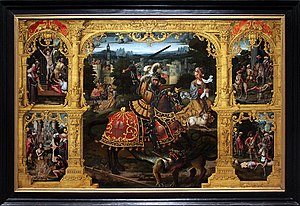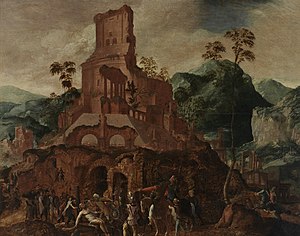


Lancelot Blondeel, also Lanceloot (1498 – 4 March 1561), was a Flemish artist active in Bruges. He worked as a painter, architect, city planner, surveyor and cartographer, and designed sculptures, tapestries and jewelry.[1][2][3]
Blondeel was born in Poperinge, and established himself as an artist in Bruges. He became a member of the Guild of Saint Luke in 1519.[4]
He trained Pieter Pourbus, who married his daughter Anna in 1543 and eventually took over his atelier.
He primarily painted commissioned religious themed works for local churches. In 1550 Blondeel and Jan van Scorel were commissioned to restore Jan van Eyck's celebrated Ghent Altarpiece.
He made in 1549 on a commission by Charles V, Holy Roman Emperor, two triumphal arches, based on the Roman style. He also designed a canal that linked Bruges to the sea, a project that greatly promoted Bruges' trade.
Blondeel died in Bruges on 4 March 1561.[1]